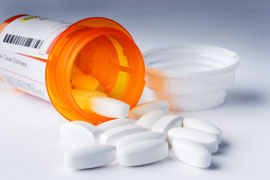Cronkite News has moved to a new home at cronkitenews.azpbs.org. Use this site to search archives from 2011 to May 2015. You can search the new site for current stories.
Officials: National drug shortage having distinct effect in Arizona
PHOENIX – A national drug shortage is endangering patients’ health and forcing doctors, pharmacists and first responders to scramble to find supplies, according to experts who shared their stories with Cronkite News Service.
“It’s a terrible problem,” said Tom Van Hassel, vice president of the Arizona State Board of Pharmacy and director of pharmacy at Yuma Regional Medical Center. “On any given day, there are 15-20 drugs we’re scrambling to find.”
Pharmacists, especially in rural Arizona, are paying more and spending more time to get drug supplies, Van Hassel said.
“These are drugs used every day in our hospital. I don’t think any hospital in the state has escaped this shortage,” he said. “When we’re out, we’re truly out. The nearest hospital is 150 miles away.”
Van Hassel said a pill that used to cost 40-60 cents may now cost $8-$20.
Rural hospitals can be especially susceptible to drug shortages, said Neil MacKinnon, director of the Center for Rural Health at the University of Arizona’s Mel and Enid Zuckerman College of Public Health.
“The supply chain is more fragile in rural settings, so when the drug is short, it can impact care for the entire community,” he said. “In that case, the surgery has to be postponed or the patient has to go to a different community to receive care.”
Van Hassel blamed the shortage on an inconsistent supply of raw materials to drug makers and the consolidation or closing of manufacturing plants.
Plus, once some suppliers realized shortages could occur, they bought up supplies, he said.
“It’s like a snowball going downhill,” Van Hassel said. “When one product runs out, everyone goes to the second and then the third.”
Going to second and third choices is a common occurrence for Dr. Sean Elliott, a pediatrician who oversees infection prevention for the UA Health Network.
With a girl who’d been on a heart-lung machine for three months, Elliott said he was worried about side effects from a drug that wasn’t his first or second choice.
“I was forced to use an antibiotic called Colistin, which is highly toxic to kidneys,” Elliott said, “and at the time, my patient’s kidneys were one of the only working organs in her body.”
The drug stopped the resistant infection, and the girl’s kidneys are working, too, Elliott said. But he added that doctors must be creative to deal with the drug shortage.
In addition to antibiotics, the most severe shortages have been for cancer drugs, anesthesia and pain control medication.
Nationwide, the situation is not as critical as it was 18 months ago, according to Joe Hill, director of Federal Legislative Affairs for the American Society of Health-System Pharmacists.
“It’s still pretty bad,” he said.
The shortage may get worse since the New England Compounding Center in Massachusetts suspended operations after tainted pain shots caused deaths in 23 states.
“It’s something very concerning to us,” Hill said. “We’re bracing for that impact. We think it’s going to be problematic.”
The shortage has led to medical errors because health care providers are not as familiar with second-choice medications, said Dr. Melinda Burnworth, a member of the Arizona Pharmacy Association and an associate professor at Midwestern University College of Pharmacy-Glendale.
“It’s not fatalities – it’s more close calls or near misses, meaning that the medication was dispensed and an inappropriate amount was given to the patient or a different concentration was not intended for the patient,” Burnworth said.
To avoid errors, Brian Ziegler, director of pharmacy services at Banner Desert Medical Center, said he spends time educating physicians, nurses and pharmacists about alternative drugs.
“We encourage them to double-check the dosage,” he said. “The shortage is severe, but we’ve worked very hard to have it not affect the care of our patients.”
Even the Phoenix Fire Department, which provides ambulance service to Maricopa County, has experienced drug shortages, but it hasn’t had to withhold medications from patients, Capt. Larry Nunez said.
The ambulances aren’t carrying Valium, but there is a substitute for it on board, he said.
“When we call another station and ask them to bring us out some drug, they’ll say, ‘We’ll only bring you a couple,’” he said. “We’ll rob Peter to pay Paul from another station if we have to.”
The hidden cost of the drug shortage – time spent away from patient care trying to find drugs – is as high as $216 million, Midwestern’s Burnworth said.
“There’s a tremendous amount of resources, personnel devoted to this whole process,” said Dr. Rob Wolf of the Mayo Clinic in Rochester, Minn., where he is the pharmacotherapy director for hematology and oncology.
“Individuals who could be doing other aspects of care spend a significant amount of time understanding, planning and making changes associated with these shortages.”
A silver lining of the shortage may be that pharmacists and doctors are talking to each other and to colleagues in other facilities.
“Our hospital complex and I’m sure all the others as well have become very, very good at communicating with each other and trying to be proactive,” said the UA’s Sean Elliott. “We’re facing the challenges.”







